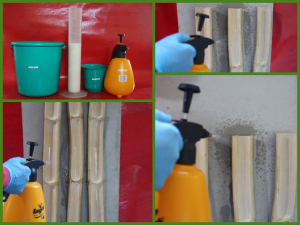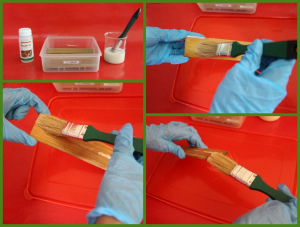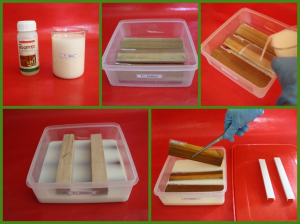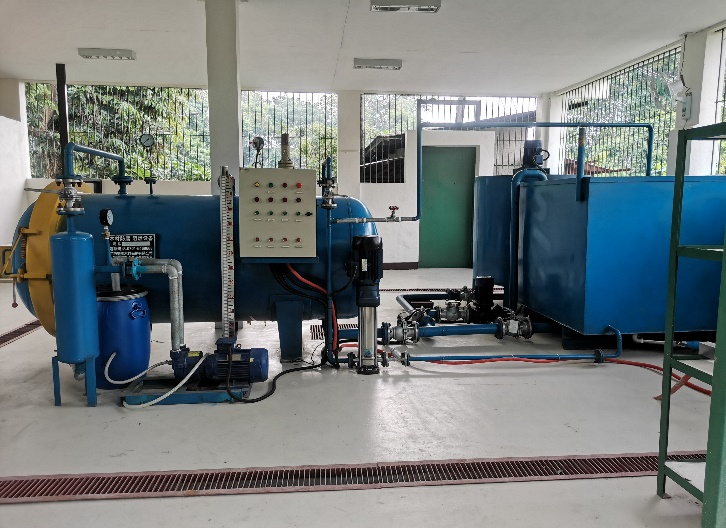Chemical Treatment
Bamboo, being rich in starch content and hygroscopic in nature, succumb to various biological deteriorating agents such as fungi and insects, specifically the powder post beetles. As a result, the service life and value of these raw materials can become shorter and lower. This problem can be addressed by the application of necessary and effective postharvest treatments to essentially enhance the durability of bamboo during storage and its finished products. These treatments can be classified as chemical and non-chemical methods.
CHEMICAL METHOD
Preservative treatment involves the application of preservatives for bamboos. Preservatives can be of organic or synthetic type of fungicides or insecticides. The use of plant-based extracts is a form of organic preservatives which can be applied to alleviate the problem of fungi infestation of bamboos. Some synthetic preservatives are also utilized which contain active ingredients such as deltamethrin, propiconazole, tebuconazole, or permethrin.
Treatments involving chemicals are highly effective but costly and can inflict environmental hazards if not well-handled. Method of application of these preservatives depends on the volume and size of the raw materials being treated.
Methods of preservative application
- Spraying – Thorough spraying of the chemical provides protection to freshly cut, bulk-piled raw materials against staining fungi or beetle attack. Bulk piling minimizes loss of chemical in the process since the poles are close to one another

2. Brushing- The preservatives are applied to the cut or injured portions of the materials. Good for very small quantity of materials to be used in the handicraft or cottage industry. The penetration of the preservatives is only superficial.

3. Dipping or soaking in preservatives – Gives better result than brushing. Raw materials, either freshly cut or kiln dried, are dipped or soaked in a fungicidal or insecticidal solution for 5 to 10 minutes for protection against staining fungi and powder-post beetle attack. The fungicidal solution can be prepared in a dipping vat made of galvanized GI sheet or a trench dug in the ground and lined with a plastic sheet.

4.1 Pressure method – Raw materials are placed in a tightly closed pressure cylinder to undergo vacuum treatment at a specific time duration. This stage enables the removal of as much air as possible from the cells of bamboo being treated. Once done, the raw materials are subjected to preservatives such as chemicals wherein pressure treatment plays a big role. In pressure treatment, the cylinder must initially be filled with preservatives followed by the introduction of pressure to allow the materials to reach the desired level of preservative absorption. The preservatives will then be drained from the cylinder. Vacuum treatment will again be done to drain excess preservatives.

Types of wood preservatives/chemicals
- Fungicide alone (against fungi)
- Propiconazole (1:50 v/v)
- Disodium octaborate tetrahydrate or DOT (12%)
- Tebuconazole + Trifloxystrobin (0.375g/100ml
- Insecticide alone ( against insects)
- Deltamethrin (1:100 v/v)
- Permethrin (Ready to use or RTU)
- Combination of Fungicide +Insecticide (against fungi and insects)
- Permethrin + Tebuconazole (RTU)
- Deltamethrin + Propiconazole (Tank mix – 1:100 + 2:100 v/v)
Science in a creative industry.
The DOST-FPRDI has a Bamboo Musical Instruments Innovation R&D program aimed at improving the quality of locally-made bamboo musical instruments (BMIs) through science and innovative technologies. The program seeks to standardize the production of selected BMIs, develop prototype designs, analyze raw material sources and existing markets, and build a BMI processing facility. In addition, the program aims to document the ethnocultural story behind several BMIs and identify the bamboo species used in BMI production to promote public awareness and appreciation of the cultural importance of these musical instruments. The program is a collaboration with the University of the Philippines and Philippine Normal University for teaching modules and analyzing sound quality and standardization of BMI design. The DOST Grants-in-Aid program provides funding.
PhBMI

